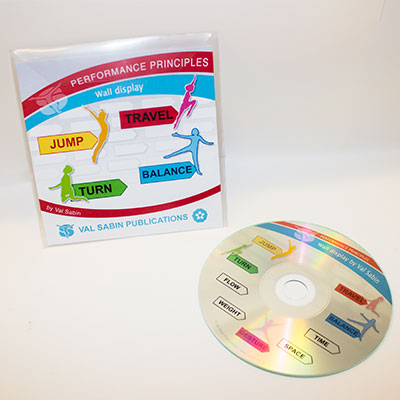Val Sabin Performance Principles:

Performance Principles is a model comprising core physical skills and movement principles arranged in a way to encourage a higher quality of self-evaluation and analysis, and evaluation of others.
It can also be used as a check list to make better quality assessments.
The performance principles can be ordered on CD and printed off to create a large wall display. To promote more independent learning.
Introduction To Performance Principles
Included on this CD is a wall display which enables children to record different types of movement in the core skills as they experience them. This display can be arranged to suit the needs of the school and the environment.
Compare creating a sequence with composing a sentence of words. We do not expect children to write sentences unless we have helped them to acquire an appropriate vocabulary of words and guided them on acceptable grammatical structure.
Sentences always begin with a capital letter and conclude with a full stop.
In the same way, with gymnastic sequences, we should help children to acquire a basic vocabulary of skills and abilities for the theme or focus of work, and then to understand the principles involved in linking them logically and creatively. Sequences should always show clear starting and finishing positions.
A balanced sequence contains examples of movement from each of the core skills category (Travel, Jump, Turn, Balance) and should be developed and made more challenging through the use of Laban’s Principles of movement (Time, Space, Weight, Flow)
How can it be used
The “Performance Principles” model (© Val Sabin) could be used as a visual reference, when appropriate, to help children understand how to create, construct, develop and refine a sequence. It will encourage pupils to develop their independent learning and skills and help them to evaluate and assess themselves and the work of others.
Each of the core skills categories is defined by a primary colour.
- Travel – Red
- Jump – Yellow
- Turn – Green
- Balance – Blue
Laban’s Principles of movement are defined in white.
- Time
- Space
- Weight
- Flow
Formula
A well balanced sequence should contain activities from each of the four primary colours and be refined, developed, and made more challenging by applying the “Principles of Movement” defined in white. Analysis of a finished sequence should reveal activities and aspects from each “arm” of the Performance Principles Model.
Application
Arranged on a wall in the hall or gym, children in Key Stage 1 can gradually be made familiar with the different aspects of movement as they occur in their gymnastics scheme.
By the end of Key Stage 2 they should thoroughly understand the composition of a balanced sequence and know how to make it more challenging.
In Key Stages 3 and 4 the “Performance Principles” Model can provide a valuable visual tool for analysis and evaluation as well as ‘prompt’ pupils on how to develop and improve their own and others work.
However simple or complex the sequence may be, this visual aid will provide an invaluable check-list, for self evaluation and can play an important role in developing the quality of assessment.
Extension
Because the fundamentals of movement are constant (travel, jump, turn and balance) with the addition of “Gesture” (to add meaning, expression and intention) the performance principles can also be used to help pupils develop a balanced and well-choreographed movement, phrase or dance.
N.B. “The language of Dance” divides “balance” into “being still” and “holding a shape” because in dance stillness can have many meanings, depending on the way the pupils move into it (e.g. by freezing, holding, pausing or settling) and on the context of the dance.
This detail can be enlarged at the appropriate time, but certainly in KS1. And much of KS2, working to the term “balance” will be more easily absorbed into their movement vocabulary.
In key stage 3 pupils can be guided to look at the model in terms of “The Language of Dance” i.e.
- What is the body doing (all the coloured sections) travel, jump, turn, balance (being still and making a shape) and gesture
- How is the body moving (white sections) time, weight, flow
- Where are the movements going to be performed (white section) space
- With whom or what are the actions performed (white section) space – (relationship space – individual, in a pair, in a group or with a prop.)
Price
£11.00 (CD)
Please contact us to place your order.

